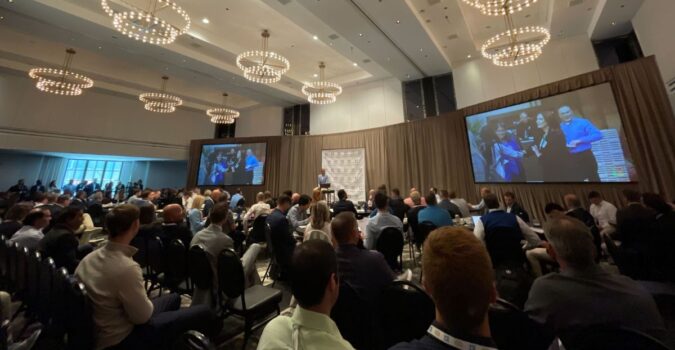What It Takes to Build AI Agents That Drive Business Impact
Agentic AI is rapidly becoming the most transformative force in enterprise automation. Moving beyond traditional scripts or chatbot logic, modern AI agents operate with autonomy, perceiving their environment, reasoning through complex tasks, and acting without constant human intervention.
But building AI agents isn’t just about picking the right model. It’s about assembling the right stack, designing for scale, and embedding agents in real workflows that drive tangible business outcomes. For enterprises, that means rethinking how work is done, from repetitive tasks to strategic initiatives.
Whether you’re a CTO, product leader, or innovation team lead, building effective AI agents means bridging technical sophistication with business impact.
In This Article
- What It Means to Build AI Agents
- 5 Core Components of a Robust AI Agent
- Top Frameworks for Building AI Agents
- Agentforce and the Future of Enterprise AI
- Practical Tips for Building AI Agents That Work
- What Makes a Great Agentic AI Developer?
- The Future Is Agentic: Why Now’s the Time to Start Building
What It Means to Build AI Agents
Building AI agents represents a fundamental shift in how enterprises approach automation. Unlike traditional rule-based systems, AI agents operate independently, interpreting high-level goals and executing actions through intelligent decision-making.
To build AI agents is to design autonomous systems that move from input to action without needing explicit, step-by-step instructions. Unlike static models that require predefined workflows or command sequences, agents are built to operate on goals. They take initiative, plan their own paths, and determine how best to complete a task.
This means developers and product teams are not just coding actions. They’re defining boundaries, crafting memory structures, selecting toolsets, and curating contextual data to enable intelligent, adaptable behavior. Building the best AI agents is more akin to assembling a digital team member than programming a tool.
The output? Systems that don’t just execute tasks, but actually understand them, adapt to evolving inputs, and collaborate with humans and systems to get better over time.
5 Core Components of a Robust AI Agent
Constructing a reliable AI agent involves more than just selecting a model or plugging in APIs. It requires assembling multiple interconnected layers that enable the agent to reason, act, and improve over time.
To build an agent that performs in a business context, you need more than an LLM. Think of the AI agent as a system composed of interdependent parts that must work together seamlessly.
1. Reasoning Engine
At the core is a planning engine—typically powered by an LLM or specialized inference system—that interprets goals, evaluates context, and dynamically selects the best next action. The engine enables autonomy, allowing agents to make decisions instead of waiting for prompts.
2. Memory Layer
Context is everything. Short-term memory helps agents stay coherent during a session, while long-term memory enables learning over time. Tools like vector databases, session logs, or purpose-built memory frameworks like LangGraph or Atlas provide this persistence.
3. Toolset and Actions
This is where agents go beyond language and into execution. Toolsets define what agents can do—pull data from a CRM, send messages, trigger workflows, update dashboards, etc. Each tool expands the agent’s operational capabilities, transforming it from a chatbot into a business operator.
4. Data Context
Without the right context, even the smartest agent will fail. Agents must be fed structured, reliable data—customer records, operational statuses, historical interactions, and more—to reason accurately and take action with confidence. Integrating with enterprise systems and APIs is essential.
5. Guardrails and Policies
Autonomy must be paired with accountability. Guardrails enforce ethical behavior, compliance requirements, and operational constraints. These include rate limits, access controls, escalation protocols, and logic boundaries that ensure agents don’t act beyond their intended scope.
Top Frameworks for Building AI Agents
Choosing the right framework can make or break your AI initiative. With a growing ecosystem of agentic tools available, understanding the unique strengths and trade-offs of each framework is critical.
Different AI agent frameworks offer varying advantages depending on your use case, team expertise, and scaling goals. These are some of the most widely adopted and flexible frameworks in the space today:
LangChain
LangChain is an open-source framework built for composing LLM applications. It allows developers to create complex, multi-step agent flows by combining LLMs with tools, memory, and custom logic. It’s ideal for innovation teams and early-stage development where experimentation and speed are priorities.
Use cases:
- Prototyping new agentic behaviors
- Rapid iteration for internal tools
- Experimenting with memory/tool integrations
AgentOS
Built with enterprise deployment in mind, AgentOS delivers strong support for observability, performance monitoring, and operational scale. It offers native support for governance, team collaboration, and extensibility, making it ideal for AI agents in production.
Use cases:
- Multi-team collaboration
- Production-ready applications
- Regulated environments that need strong oversight
CrewAI
CrewAI focuses on multi-agent collaboration. It allows you to design specialized agents with different roles and skill sets, then coordinate them as a team. This is ideal for scenarios like project planning, financial analysis, or customer support involving escalation paths.
Use cases:
- Cross-functional agents working together
- Complex decision-making processes
- Emergent behavior testing
AutoGen
Developed by Microsoft, AutoGen is a research-driven framework that supports advanced reasoning, tool orchestration, and multi-agent conversations. It integrates well with Azure and Microsoft’s ecosystem, making it a strong option for companies already aligned with that stack.
Use cases:
- Advanced planning and task decomposition
- Integrations with Microsoft Azure
- Agents that require real-time collaboration
Agentforce and the Future of Enterprise AI
When it comes to deploying AI agents at scale, frameworks alone aren’t enough. Agentforce offers a full-stack solution purpose-built for enterprise deployment—bridging data, governance, and usability within the Salesforce ecosystem.
Developed within the Salesforce ecosystem and powered by Data Cloud, Agentforce enables businesses to embed intelligent agents directly into their operations.
In practice, Agentforce enables teams to quickly deploy service agents, sales agents, and operations agents—all working with real business data and delivering measurable ROI. For enterprises already in the Salesforce ecosystem, it’s a clear path to production-ready agents that scale.
Key advantages:
- Tight Integration with Salesforce: Use real-time CRM data to make agents context-aware.
- Omnichannel Functionality: Deploy agents across Slack, email, web, and mobile channels.
- Governance Built In: Set permissions, monitor activity, and audit decisions in real-time.
- Low-Code Extensibility: Build agents without needing to write every line of code from scratch.
Practical Tips for Building AI Agents That Work
Even the best tools and frameworks won’t deliver results if agents aren’t thoughtfully designed. To avoid common pitfalls and drive real ROI, teams need to think like engineers and product owners simultaneously. This section distills some of the most effective strategies for ensuring your AI agents are both functional and impactful.
There’s a gap between building something that “runs” and something that delivers business value. These best practices help bridge that gap:
- Start with One Use Case: Focus on a narrow, high-value problem. This helps you stay lean, test faster, and generate quick wins.
- Design for Observability: Logging and metrics are not nice-to-haves—they’re foundational. You need to understand agent behavior, inputs, outputs, and edge cases.
- Build Human-in-the-Loop Pathways: Agents should know when to escalate. Confidence thresholds, fallback mechanisms, and human approval steps build trust.
- Test Edge Cases Intentionally: Don’t just test the happy path. Simulate error conditions, conflicting goals, and unexpected inputs to harden your agent.
- Plan for Platform Alignment: Choose agent frameworks and platforms that work well with your existing tech stack and business goals. Avoid lock-in by favoring extensibility.
- Document Everything: Internal docs, behavior guides, tool definitions, and known limitations help future developers and ensure repeatability.
- Prioritize Business Outcomes Over Novelty: Always tie agent development to measurable KPIs—whether that’s time saved, cost reduced, or revenue generated.
- Invest in Post-Launch Training: Continuously improve your agent through user feedback and updated training data. AI agents aren’t “set and forget”—they’re iterative products.
What Makes a Great Agentic AI Developer?
Building AI agents is the next evolution in enterprise automation. Done right, AI agents become digital coworkers that scale operations, surface insights, and free teams to focus on strategic work.
Whether you start with a lightweight prototype or invest in a platform like Agentforce, the key is intentionality: design with purpose, build with scale in mind, and tie everything to real outcomes.
Agentic AI isn’t about replacing people. It’s about augmenting your workforce with intelligence that scales, and the time to start building is now.
Great AI agents don’t build themselves—they’re built by teams that understand both the human and technical sides of automation. So what defines a great agentic AI developer?
Hybrid Thinking
Effective AI builders are not just coders—they’re systems thinkers who understand business logic, user experience, and technical architecture. They can think like product managers and data scientists at the same time.
Comfort with Ambiguity
AI agents often operate in open-ended environments. Developers must be comfortable designing for uncertainty, defining fallback behaviors, and engineering systems that can adapt without breaking.
Deep Curiosity
Agentic developers explore new tools, test unconventional solutions, and question assumptions. Their curiosity drives innovation, helping organizations build agents that truly improve how work gets done.
Collaboration Skills
Building agents is inherently cross-functional, requiring input from product, data, operations, and engineering. The best agentic developers know how to collaborate, communicate, and translate between teams.
Ethics and Responsibility
Autonomous systems need boundaries. Developers who build for agentic environments must consider bias, privacy, and fairness, not just functionality. Ethics isn’t optional in this space.
The Future Is Agentic: Why Now’s the Time to Start Building
Agentic AI is more than a trend; it’s a shift in how enterprises scale, automate, and drive impact. The tools to build AI agents are here, and leading companies are already embedding them into real workflows.
This isn’t just about efficiency. It’s about building smarter systems that act, adapt, and collaborate. With platforms like Agentforce, even non-technical teams can start small, prove value, and scale quickly, without adding operational complexity.
If you’re aiming for sustainable growth, now is the time to act. Align your team, identify your highest-impact use case, and build agents that drive real outcomes.
Ready to take the next step? Let’s start a conversation.



